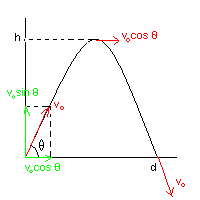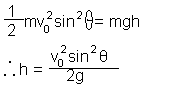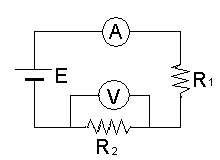物理学(ぶつ、り、がく)= physics; 用語(よう、ご)= terminology; 力学(りき、がく)= dynamics/mechanics; 電磁気学(でん、じ、き、がく)= electromagnetism; 問題(もん、だい)= problem/question; 解答(かい、とう)= solution; 熱(ねつ)= heat; エネルギー= energy; 光学(こう、がく)= optics; 電気(でん、き)= electricity; 波動(は、どう)= wave motion; 相対性理論(そう、たい、せい、り、ろん) = the theory of relativity; 音(おと)= sound
問題)質量m[kg]の物体が、初速υ0[m/s]で、水平面からθの角度で、空中に投げ出された。この時、
(1)この物体は最高何メートルまで上がるか。
(2)この物体の落下地点は、投射地点から何メートルの距離にあるか。
(3)落下した時の速度は何[m/s]か。
ただし、重力加速度をg[m/s2]とし、空気摩擦は無視できるものとする。
ヒント:力学的エネルギー保存則を使え。
VOCABULARY:
質量(しつ、りょう)= mass; 物体(ぶっ、たい)= an object/body; 初速(しょ、そく)= the starting velocity; 水平面(すい、へい、めん)= the horizontal; θ(シータ)= theta; 角度(かく、ど)= angle; 空中に(くう、ちゅう)= in the air; 投げ出す(な、だ)= to project/thow outward; 最高(さい、こう)で= at the most/highest; メートル= meter; 落下地点(らっ、か、ち、てん)= the falling point; 投射地点(とう、しゃ、ち、てん)= the projection point; 距離(きょ、り)= distance; 落下する= to fall; 重力(じゅう、りょく)= gravity; 加速度(か、そく、ど)= acceleration; 空気(くう、き)= air; 摩擦(ま、さつ)= friction; 無視する(む、し)= to ignore; 力学的エネルギー保存則(りき、がく、てき;ほ、ぞん、そく)= the law of conservation of mechanical energy
TRANSLATION:
Problem) An object with the mass m[kg] has been projected at the starting speed υ0[m/s] at the angle θ with respect to the horizontal. Now,
(1) How high will the object reach at the most?
(2) What is the distance between the starting point and the falling point?
(3) What is the speed of the object when it has fallen on the ground?
Note: Assume that the acceleration of gravity is g[m/s2], and that the firction of the air can be ignored.
Clue: Use the conservation law of mechanical energy.
The following is a sample solution.
解答)
 (1)力学的エネルギー保存則により、
(1)力学的エネルギー保存則により、




 問題)右の図の回路において、
問題)右の図の回路において、
(1)電流計Aは何アンペアを示すか。
(2)電圧計Vは何ボルトを示すか。
ただし、 抵抗R1=2Ω、 抵抗R2=3Ω、 電池E=10Vとし、 電流計の抵抗はゼロ、 電圧計の抵抗は無限大とみなされるものとする。
VOCABULARY:
右(みぎ)= right; 図(ず)= figure; 回路(かい、ろ)= circuit; 電流計(でん、りゅう、けい)= ammeter; アンペア= ampere; 電圧計(でん、あつ、けい)= voltmeter; ボルト= volt; 示す(しめ)= to show; 抵抗(てい、こう)= resistor; オーム= ohm; 電池(でん、ち)= battery/cell; みなす= to assume
TRANSLATION:
Problem) In the figure on the right,
(1) How many amperes does the ammeter A show?
(2) How many volts does the voltmeter V show?
Note: Assume Registor R1 = 2Ω, Registor R2 = 3Ω, and Battery E = 10V. Assume also that the registance of the ammeter is zero, and that that of the voltmeter is infinity.
The following is a sample solution:
解答)
(1)オームの法則により、 E=I(R1+R2)。それゆえ、